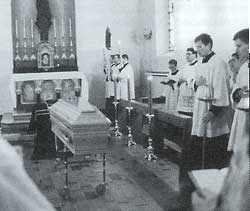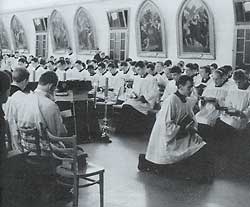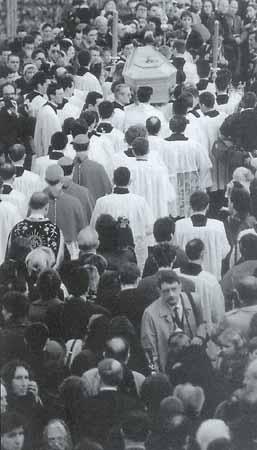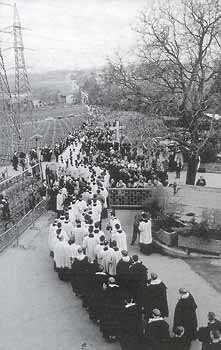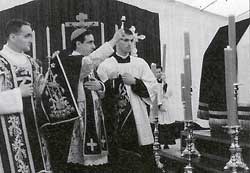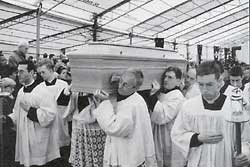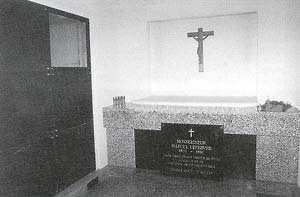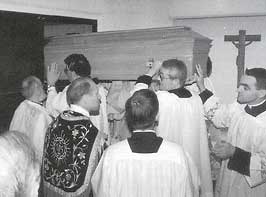In Memoriam Archbishop Marcel Lefebvre, Pt. 3
Part 3
Eric Bertinat
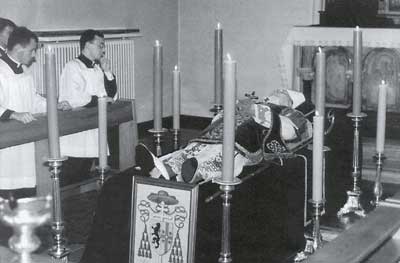
Archbishop Lefebvre lying in state in the chapel of Our Lady of the Fields
in the seminary of Ecône as the seminarians pray.
On this March 25, it will have been 11 years since the death
of Archbishop Marcel Lefebvre. This account of his Requiem Mass
and funeral appears in English for the first time.
Ecône, Monday, March 25. A surprising calm reigned over the seminary. At 3:30 this morning, Monsignor Lefebvre committed "his beautiful soul to the hands of God" as the seminary rector, Fr. Simoulin, posted it on the bulletin board situated at the entrance of the grande chapelle. Neither the professors nor the seminarians seemed distraught. There was no sign of excessive sadness on the faces of the household of Ecône, only this majestic calm perceptible by all those who were to come to the seminary on this day. And yet, professors and seminarians had, since 11:30 p.m., spent the night in prayer to commend to God the soul of their father in the priesthood.
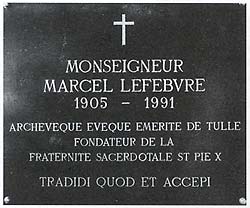 |
Today was the day of the Feast of the Annunciation, although this solemnity was not celebrated because of Holy Week. How could we not see the visible sign of providence which, on this day when everything began for fallen humanity, took back from us the man who allowed everything to continue despite the ugliness and wickedness of men, and too often of clergymen?
His Excellency, in his eternity, left to us the only heritage that he could–and had–to give us: Tradition, whole and inviolate, along with, to protect it and to propagate it, some 400 priests and seminarians spread through 23 countries. Among the thousands of bishops having received the same mission, only two knew how to perform it: Archbishop Lefebvre and Bishop Antonio de Castro Mayer. The latter would rejoin his old friend in heaven a month later on the same day, on the Feast of St. Mark.
This Monday was a day of great sorrow for the Society of Saint Pius X, yet without excitement, nor any sentimental outpouring, His Excellency has died, his work fully accomplished. This is the reason why, on the contrary, there was almost joy in the hearts of those who were attending to their tasks at the seminary. Many a journalist was to be surprised by it. They did not understand this feeling of finished work, a feeling that was shared more particularly by all those who had the good fortune to come close to His Excellency these last months.
Fr. Simoulin was very tired. Barely a few moments of rest could be taken after the night spent in the hospital of Martigny, attending to His Excellency until his last breath, a night inscribed forever in his memory. But already the planning of the week–an exceptional week–occupied him, but did not preoccupy him....A peerless, praiseworthy plan that would permit thousands of people to come and pay their respects to the mortal remains of His Excellency and to pray in calm and peaceful contemplation for the repose of his soul.
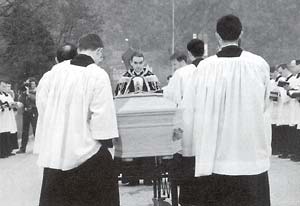
Tuesday, March 26. On the day following the death of Archbishop Lefebvre, an uncommon activity prevailed in the seminary. After breakfast, Fr. Simoulin left Ecône, accompanied by two seminarians. They went to the hospital of Sion to prepare His Excellency, and then bring him back to the seminary.
At 2 p.m., the seminarians began assembling in the courtyard of the seminary to go in procession to the foot of the access road that leads to Ecône. The fruit trees beginning to blossom, the snow still covering the mountains, the Feast of Easter in a few days...the two ranks of seminarians, cassocks whipped by a violent wind and praying under a gray sky while awaiting the remains of the founder of their Fraternity, remain so many ever-so distinctive images of this very special afternoon.
Some journalists prowling in the vicinity came to see what was happening; the Suisse-Romande television was also there.
More than one hour passed before the funeral procession appeared on the main road. Once started on the access road to Ecône, the vehicles stopped just before the seminarians. Quite calmly, without haste, the coffin was laid out on a stand. Fr. Simoulin blessed the coffin, surrounded by members of the seminary, with the brother of His Excellency, Michel Lefebvre, and with a few of the faithful, among whom were the chauffeurs of His Excellency, (who would, when their turn came, carry the coffin).
Then, a team of six people carried His Excellency up to the courtyard of the seminary.
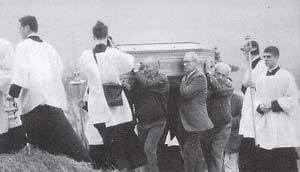
The car chauffeurs of His Excellency, aided by Michel Lefebvre,
took their turn carrying the coffin.
4 p.m.: The remains of His Excellency entered into the Seminary. How could we forget the apprehension that His Excellency sometimes showed, of not being able to rest after his death here at Ecône, which he loved so much? His chauffeurs well knew....
Then the members of the family, as also some close friends and the seminary were authorized to go to the Chapel of Our Lady of the Fields, on the second floor. I was the only one among the journalists to have permission to go to the chapel. The coffin, still closed, was placed in front of the stand on which his body would lie in state. A few prayers were said; afterwards, we were all invited to withdraw during the time necessary to prepare His Excellency, a time which seemed very long to us. During this wait, numerous faces betrayed the sorrow that everyone kept to themselves.
But, we were among friends....
At 4:25 p.m., Fr. Simoulin came to get us. His Excellency reposed in front of us on the great black cloth which covered the stand on which his body lay in state. He was at the foot of the altar, surrounded by ten candlesticks; at his feet, his coat-of-arms; to his right, his crosier.
The head of His Excellency capped with a white mitre rested on a violet-colored cushion. His face was very handsome, very pale (His Excellency had to take oxygen in his last days). His eyes were slightly open, a slight smile floating from his discolored lips. Around his neck was his pallium, symbol of the plenitude of pontifical power exercised in communion with the Apostolic See, which he had not worn since Dakar. Two benches, one on his right and one on his left were arranged for the members of the clergy. The faithful remained behind in the pews of the chapel. At the exit of the chapel, two visitor books awaited those who desired to express a final written testimonial. The seminarians took turns near the remains of His Excellency during the hours when his body was viewed by the public, that is to say, until Easter Monday.
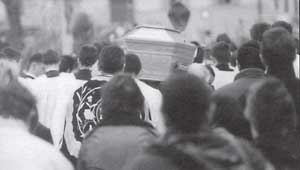
The funeral procession approached the main seminary building.
Wednesday, March 27. Msgr. Rovida, Apostolic Nuncio to Switzerland, as well as Msgr. Schwery, Bishop of Sion, came to Our Lady of the Fields chapel, and, after having prayed and blessed the body of His Excellency, they simply signed the book of condolences.
Monday, April 1. Dom Gerard, Father Abbot of the monastery St. Madeleine du Barroux, accompanied by two monks, came to turn his thoughts to God for some time in the small mortuary chapel.
At 8:45 p.m., His Excellency was moved from Our Lady of the Fields chapel to the main chapel. Already numerous priests were there as well as the four Bishops consecrated by His Excellency. In great silence, the remains of the Bishop were placed before the altar. On each side the professors and seminarians surrounded him with filial devotion. The Vespers of the Dead were sung with a most characteristic piety. Again this was an unforgettable moment.
|
All night, His Excellency was watched over by the members of the seminaries of Flavigny, Zaitzkofen, and, of course, Ecône, by the priests, the brothers, the nuns (more than 200) and the faithful who were arriving all night long, with only one concern, this last sight that they would have of their Bishop, these last prayers that they would say at his side. The complete office of Matins of the Dead, which comprises three nocturns, was sung. Each nocturn was sung by a different seminary: first, the one of Flavigny, then by the one of Zaitzkofen, and finally, at dawn, by the seminary of Ecône.
Tuesday, April 2. The Funeral Mass. During the night, thousands of faithful arrived at Ecône. By morning, there were more than 10,000 who had come from every corner of Europe as well as from the Americas and from Africa. The parking lot was filled with more than 2,000 cars from nearly every country parked there during the funeral ceremonies. The tent, which could only accommodate about 4,000 people, proved to be much too small, even before the commencement of the ceremony. Only a third of the people were able to find a place under the tent.
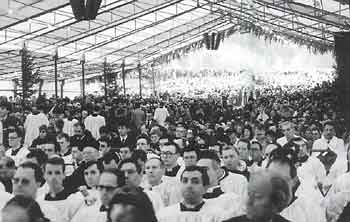
Beginning at 8:30 a.m. in the court of the seminary, the family, the priests, and the seminarians, as well as monks and nuns from friendly orders surrounded the coffin placed at the foot of the statue of St. Pius X. Also present was Fr. Hyacinth Dione, Chancellor of the Bishop of Dakar, Bishop Thiandoum, who officially attended as his representative.
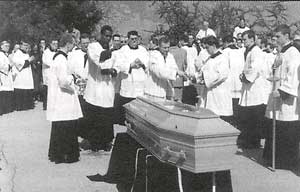
Fr. Hyacinth Dione, secretary to His Excellency Cardinal Hyacinthe Thiandoum,
blessed the remains of Archbishop Lefebvre.
At 8:50 a.m., Fr. Schmidberger left the seminary for the removal of the body: "Come, saints of God, hasten, angels of the Lord. Take his soul and present it before the face of the Most High." Placed behind the coffin were all the superiors of the districts and seminaries of the Society of Saint Pius X.
|
The choir began singing the psalms: De profundis clamavi ad Domine (Out of the depths have I cried unto Thee, O Lord). The procession, that is to say 600 clergymen, set out towards the large tent where more than 15,000 people were gathered in an impressive silence, which was to reign during the entire ceremony. Great respect and great serenity were shown: a dignity that many a journalist would note. The long cortege descended slowly towards the tent erected in the field. In front, the two lines formed by the seminarians in white surplices, who came from the last six seminaries founded by the Bishop, then the priests and brothers, more than 200, came. Among them many orders were represented: Benedictine, Capuchin, Cistercian, Dominican, and Redemptorist.
The Sisters of the Society and the Dominicans teaching at Fanjeaux also attended in great number.
Bringing up the rear of the procession were the Bishops and the Superior of the Society, Fr.Schmidberger. The Pontifical Requiem Mass was celebrated by His Excellency Bishop Tissier de Mallerais, one of the first priests of the Fraternity ordained by Archbishop Lefebvre about 20 years ago.
The ceremony started at 10 a.m., beautiful, full of respect and gratitude, and also admiration for the person who was buried this day: "Eternal rest grant unto him, O Lord; and let perpetual light shine upon him," was prayed in the Introit. Then, the choir sang the sequence, Dies irae, dies ilia, reminding us that death is only a passage, a time of rest for the just, although he must submit to the judgment of God.
The homily was given by Rev. Fr. Franz Schmidberger (see pp. 9-13 in this issue).
Then came the five absolutions at the casket. The first was given by Fr. Schmidberger, then the second by Bishop Fellay, the third by Bishop de Galaretta, the fourth by Bishop Williamson, and finally the fifth and last by Bishop Tissier de Mallerais.
As they sang "In paradisum deducant te angeli," the mortal remains of the faithful bishop advanced, carried in his coffin, accompanied by the members of the Society as well as his family. A magnificent and ever-so moving hymn, taken up in turn by the congregation, will remain one of the great moments of this funeral Mass:
May the angels take you to the heavens, may the Martyrs welcome you and that they open to you the Holy City of Jerusalem. May the choirs of angels greet you, and with Lazarus who, once was poor, may eternal rest be granted to you.
How could one forget the faithful as their eyes followed the coffin that, one last time, passed in front of them? How could we not remember the numerous times Archbishop Lefebvre walked this path as he was blessing us? At each ordination, at the consecrations...
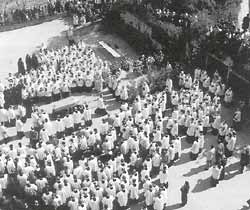
At last the coffin was placed before the burial vault. A last blessing was given by each member of the family and by each priest: "Eternal rest give to him, O Lord: and let perpetual light shine upon him."
|
Then the mortal remains of His Excellency were taken by a small group inside the vault, where as he desired, they were put to rest. On the plaque, these few words were inscribed for eternity: Tradidi quod et accepi – I have handed down what I received. |
At last the coffin was placed before the burial vault. A last blessing was given by each member of the family and by each priest: "Eternal rest grant unto him, O Lord: and let perpetual light shine upon him. |
Then the mortal remains of His Excellency were taken by a small group inside the vault, where as he desired, they shall rest. On the plaque, these few words are inscribed for eternity: Tradidi quod et accepi.
A page in the history of the Church had turned.
This account is taken from Les Cahiers de Controverses, and was translated exclusively for Angelus Press.
